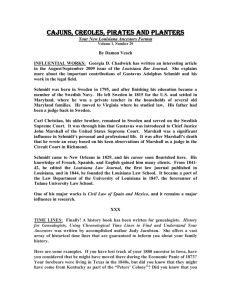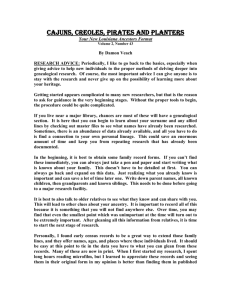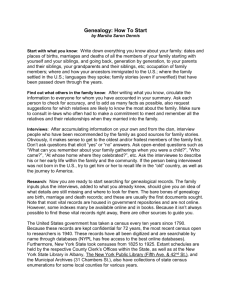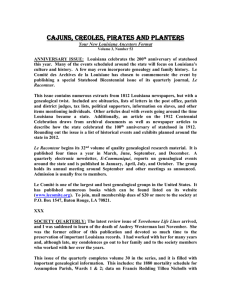CAJUNS, CREOLES, PIRATES AND PLANTERS
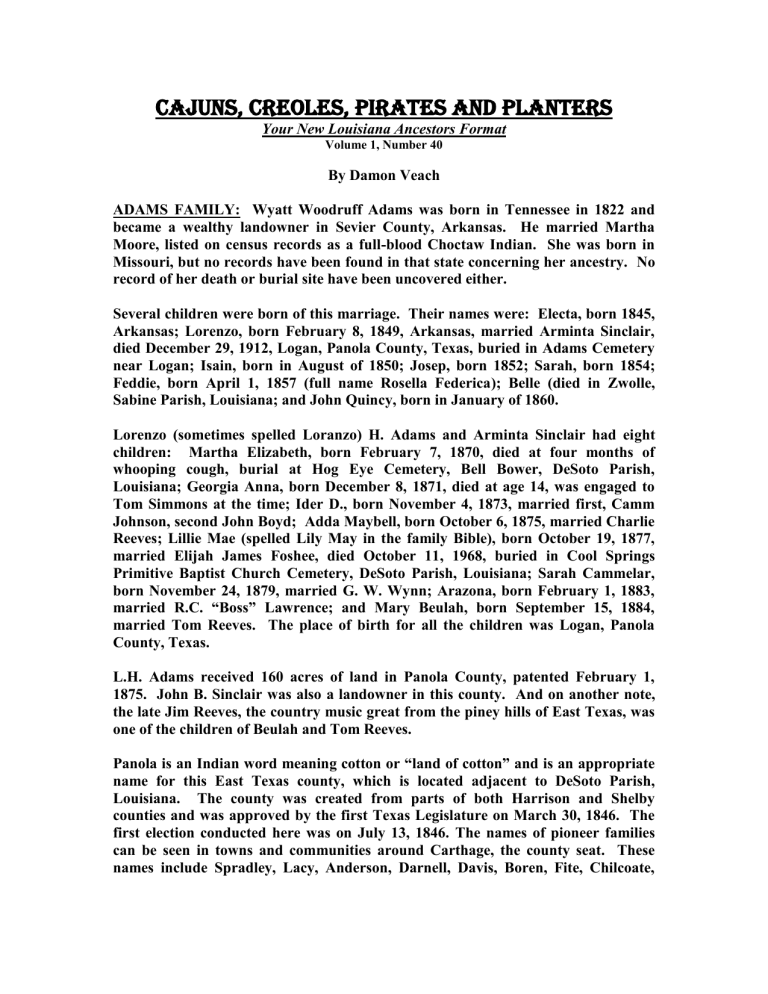
CAJUNS, CREOLES, PIRATES AND PLANTERS
Your New Louisiana Ancestors Format
Volume 1, Number 40
By Damon Veach
ADAMS FAMILY: Wyatt Woodruff Adams was born in Tennessee in 1822 and became a wealthy landowner in Sevier County, Arkansas. He married Martha
Moore, listed on census records as a full-blood Choctaw Indian. She was born in
Missouri, but no records have been found in that state concerning her ancestry. No record of her death or burial site have been uncovered either.
Several children were born of this marriage. Their names were: Electa, born 1845,
Arkansas; Lorenzo, born February 8, 1849, Arkansas, married Arminta Sinclair, died December 29, 1912, Logan, Panola County, Texas, buried in Adams Cemetery near Logan; Isain, born in August of 1850; Josep, born 1852; Sarah, born 1854;
Feddie, born April 1, 1857 (full name Rosella Federica); Belle (died in Zwolle,
Sabine Parish, Louisiana; and John Quincy, born in January of 1860.
Lorenzo (sometimes spelled Loranzo) H. Adams and Arminta Sinclair had eight children: Martha Elizabeth, born February 7, 1870, died at four months of whooping cough, burial at Hog Eye Cemetery, Bell Bower, DeSoto Parish,
Louisiana; Georgia Anna, born December 8, 1871, died at age 14, was engaged to
Tom Simmons at the time; Ider D., born November 4, 1873, married first, Camm
Johnson, second John Boyd; Adda Maybell, born October 6, 1875, married Charlie
Reeves; Lillie Mae (spelled Lily May in the family Bible), born October 19, 1877, married Elijah James Foshee, died October 11, 1968, buried in Cool Springs
Primitive Baptist Church Cemetery, DeSoto Parish, Louisiana; Sarah Cammelar, born November 24, 1879, married G. W. Wynn; Arazona, born February 1, 1883, married R.C. “Boss” Lawrence; and Mary Beulah, born September 15, 1884, married Tom Reeves. The place of birth for all the children was Logan, Panola
County, Texas.
L.H. Adams received 160 acres of land in Panola County, patented February 1,
1875. John B. Sinclair was also a landowner in this county. And on another note, the late Jim Reeves, the country music great from the piney hills of East Texas, was one of the children of Beulah and Tom Reeves.
Panola is an Indian word meaning cotton or “land of cotton” and is an appropriate name for this East Texas county, which is located adjacent to DeSoto Parish,
Louisiana. The county was created from parts of both Harrison and Shelby counties and was approved by the first Texas Legislature on March 30, 1846. The first election conducted here was on July 13, 1846. The names of pioneer families can be seen in towns and communities around Carthage, the county seat. These names include Spradley, Lacy, Anderson, Darnell, Davis, Boren, Fite, Chilcoate,
Moore, Baker, Watson, Reeves, Neal, Hawthorne, Reed, Lagrone, Hooker, Pyle,
Shahan, Soape, Thompson, Ross, Frazier, Adams, Horn, and others.
When researching family histories, it is necessary to spread out searches to neighboring states. This Adams lineage is a good example of how two states have such close ties with research. Since this is my own lineage, I found that instead of going up into Caddo Parish, the main avenue for travel was to Carthage, Texas and all the small communities between there and what is now the Logansport, Louisiana area, including Bell Bower, Keachie, and Longstreet. Going in an eastward direction, the main road led to Mansfield. With Shreveport due north, it was surprising to find that few contacts were made in this direction until later years.
For the most significant points in this shared area history, my research centered in
Carthage and Mansfield.
Do not overlook these close ties when doing your personal research, especially if you are near or sharing state lines. Also check into these areas for land grants to determine when these earlier ancestors moved into the region. As with census records, it is really working backwards, taking one clue and researching it until you have another to carry you further along. This is what I have always described as proving your way into history. Just remember, there is more to research than just learning names. A study of what is going on in the areas of settlements is sometimes extremely important when determining a complete family ancestry.
XXX
RESEARCHER’S GUIDE: In every field of research, there are certain books that need to be either in personal libraries or available at local research facilities. One such book is Val Greenwood’s Researcher’s Guide to American Genealogy. This is the best one of its kind and is now out of print. That means that you need to see if you local library has a copy or if it is available on interlibrary loan. This book was consistently praised for setting a standard of excellence in research areas.
While it instructs the researcher in the timeless principles of genealogical research, it also identifies the various classes of records employed in that research, groups them in convenient tables and charts, gives their location, explains their uses, and evaluates each of them in the context of the research process. Designed to answer practically all the researcher's needs, it is both a textbook and an all-purpose reference book. And it is this singular combination that makes The Researcher's
Guide the book of choice in any genealogical investigation. It is also the reason why you need to see if you can find one for use in your research.
The last edition incorporated the latest thinking on genealogy and computers, specifically the relationship between computer technology (the Internet and CD-
ROM) and the timeless principles of good genealogical research. It also includes a new chapter on the property rights of women, a revised chapter on the evaluation of genealogical evidence, and updated information on the 1920 census. Little else has
changed, or needs to be changed, because the basics of genealogy remain timeless and immutable. This 3rd edition of The Researcher's Guide, then, is a clear, comprehensive, and up-to-date account of the methods and aims of American genealogy--an essential text for the present generation of researchers--and no sound genealogical project is complete without it.
XXX
IMPORTANT BOOK: A history book written for genealogists is History for
Genealogists, Using Chronological Time Lines to Find and Understand Your
Ancestors. Accomplished author Judy Jacobson returns with a vast array of historical time lines that are guaranteed to inform you of your family history.
Consider the following illustrations: If you have lost track of your 1880 ancestor in
Iowa, have you considered that he might have moved there during the Economic
Panic of 1873? Your forebears were living in Texas in the 1840s, but did you know that they might have come from Kentucky as part of the “Peters’ Colony”? Did you know that you can learn a great deal about your ancestors if they belonged to a labor or fraternal organization like the Amalgamated Clothing Workers,
Brotherhood of Locomotive Engineers, or the Catholic Family Life Insurance
Society?
As Jacobson puts it, “The average person might define historical research as the study of the human past and genealogical research as the study of a human’s past.
History lays the foundation to understand a group of people. Genealogy lays the foundation to understand a person or family using tangible evidence. Yet history also lays the foundation to understand why individuals and societies behave the way they do. It provides the building materials needed to understand the human condition and provide an identity, be it for an individual or a group or an institution.”
The initial chapters of History for Genealogists explain the value of historical time lines. Here the reader learns the clues that time lines can suggest about hidden aspects of our ancestors’ lives. Jacobson illustrates the virtues of time lines with several case studies.
The bulk of her latest volume consists of specific historical time lines that answer fundamental questions about our forebears. For example, if you are trying to learn when your ancestors left one place for another, it would be helpful to ask the question, “Why did they leave?” Did it have to do with a military conflict, social injustice, religion, disease, economic hardship, a natural disaster? No matter what the explanation, this author has a historical time line that could lead to the explanation. For example, your ancestor’s departure may have coincided with the outbreak of the Crimean War, a virulent epidemic, an earthquake, or a religious war.
Other chapters pose answers to other crucial questions, such as “How did they go?” and “What route did they take?” For these conundrums, Jacobson uses time lines to lay out the history of the transportation revolutions in America (roads, rails, canals, and air travel), as well as the history of the great western trails our ancestors followed in crossing the country.
She dissects our past into scores of time lines. There is a time line of the Industrial
Revolution, American immigration, and the Labor Movement. Researchers can also make use of a time line for the history of each of the 50 states, and, in brief, for the rest of North America, Europe, and more.
History for Genealogists concludes with a helpful bibliography and an index of people and places, wars and battles. It is the one history book all genealogists should own when they are searching for fresh clues or hoping to understand what made their ancestors tick. It is available for $34.95, postpaid, from the Genealogical
Publishing Company, 3600 Clipper Mill Road, Suite 260, Baltimore, MD 21211.
XXX
QUERIES: All queries are welcomed for publication in this format. They can be any length but should have a Louisiana connection by heritage or residence of the researcher who may be interested in other areas of the country. Submittals should be sent to ancestorslaveach@cox.net
or directly to Damon Veach, Cajuns, Creoles,
Pirates and Planters, 709 Bungalow Lane, Baton Rouge, LA 70802-5337. This is a free service.
